COOL STUFF
When it came time to turn my increasingly illegible notes into this epic four part post, I spent some time looking up previews of The Speris Legacy to verify a few facts. The One Magazine puts the development start date of Speris at July 1994, which ruined my theory that Team 17 had gone mad with power after the hyper ultra multi-platform smash hit Worms and were funding any old thing - Worms and Speris were in development at the same time. I'm also very chuffed to report that I've found Cho's surname, which I knew I'd read somewhere - our hero's full name is Cho Hagwai (Amiga Computing September 1995).
Most interesting though was that the screenshots in the previews didn't match the game I'd played. I started to get worried this might be a Jazz Jackrabbit-style incident where there are dozens of unusual beta screenshots all over the place with different graphics but nobody can find the version of the game that goes with them.
Intrigued, I went back in time and assembled myself a collection of The Speris Legacy demo disk magazine covermounts, with the earliest being from April 1995.
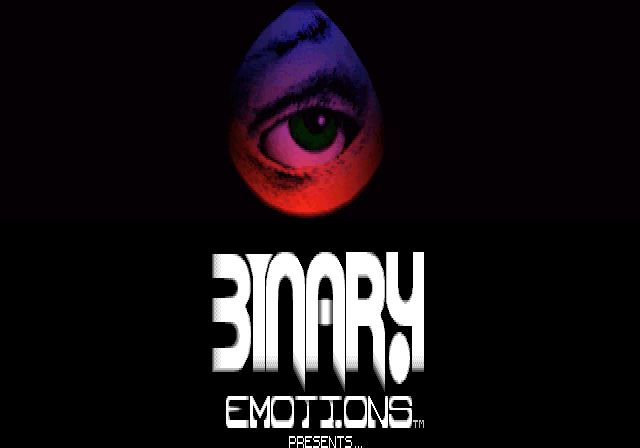
This moody, high-res thing has shades of The Hidden all over it. It's lovely!
Some utter buffoon decided that this logo wasn't going to cut the mustard. They were probably the same person who went mad with power with a 3D rendering package and gave us the pre-rendered village in the intro, because the final game ended up with this one:

First: Ew. Second: I can barely read it.

Ohhhhhhhhh, that's swish! Look at that! Are you hearing the *clink - swoosh - scrape* of the sword in your head? That's good, because it does that for real!
I went into this assuming that I'd find nothing worth showing, so this title screen was worth it by itself. Little did I know that demo Speris would look completely different.
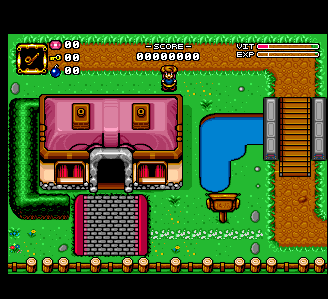
Through the magic of Internet Science, I present to you the The Speris Legacy screenshot time machine! Both the demos take place in an early version of Gilliard Rhine (just the singular!), so I've found six locations common to all three versions and matched them up. Click the teal buttons to change location, and the purple buttons to travel through time and see that location in the two demo versions and the full game.
That huge black border doesn't really exist: on a TV it would be hidden off the sides, which makes me wonder what the heck Binary Emotions were thinking moving the interface outside of the game window. The original interface was fab, and it just got worse over time. The tiny final VIT and EXP meters are atrocious. The Amiga isn't very good at layers, so moving the interface probably saved a ton of hassle at the cost of making the game look a lot more icky and Amiga-ish rather than sleek and SNES-ish like it did originally. It's also possible that they were throwing stuff together, and couldn't think of a good place to put the charge-up sword gauge once they'd decided on it, and so plopped it off the bottom and everything else followed it. The first demo doesn't have the sword gauge or daggers, so Cho can attack the bridge troll with regular sword swipes. After fighting that troll using the charge-up dagger five times now for screenshots, it's damn satisfying to be able to just hit him.
I'm ashamed to admit that I didn't notice that the scenery was any different while I was wandering about in the first demo. It was only after comparing my first set of screenshots that I noticed that the trees had transformed from bizarre orbs into sinister leafy things, and the grass had gotten progressively more detailed! Even the dialogue box got a little more textured. In fact, pretty much everything in the game had been redrawn!
Not only that, but the perspective of the interiors had changed too. Take a look at the Shop Interior or the Switch Room. The demos use an overhead perspective like A Link To The Past where you can see all four walls of the current room as if you were peering into a well. The full game has changed to an oblique Final Fantasy perspective where the walls all rise up in parallel and Cho is able to hide behind them. Everything becomes so boxy in the final game - you won't be able to un-see it if you focus on the bookcases in the Shop Interior. The Church interior was only partially redrawn, which explains why I got a headache looking at it before.
The first demo is more of a prototype than a game. It has a very small version of what would become Gilliards Rhine, with no objectives. It also has a strange system where instead of simply walking up to things you want to use and pressing Fire, you press Space instead and use a Dragon Quest style verb menu with options like PickUp, TalkTo and Operate, most of which are unfinished. There's no contextual speech bubbles, so landing Cho in the correct place to talk is difficult. Talking to NPCs and hitting monsters does work, but there's no way to open treasure chests or use the shop interface. The stairs in the back of Phillis' shop in the first demo are just a facade, and got taken out before the graphics changed.
Another strange thing in these demos...
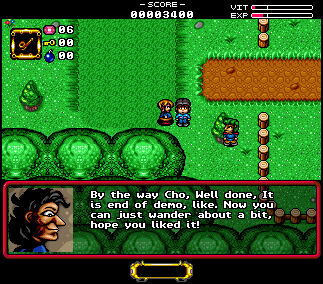
Everybody gets a portrait to show who's speaking, even Cho!
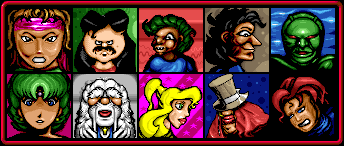
Yep, that's him in the top left, in the purple headband. You can't be a Japanese RPG hero without a headband!








Demo Cho and Final Cho are men on a mission. Demo Cho wins the slightly floppier hair award. His upwards walk is a bit strange; it looks like he's twisting his whole body left to right like someone's taped his arms to his sides. I'm not sure if he has big pointy elf ears, or his headband is really a ceremonial headdress that drops down behind his head under his hair. It's the only way his downwards walk and his portrait make sense.
The second demo has the full-sized Rhine, with a whole bunch of annoying fences and barriers that I'm thankful they took out of the final game. There's some extra monsters in the demos that appear nowhere in the full game, and a few more sound effects too. In fact, it feels like they took out tons of sound effects and enemies just so they could make the final Gilliards Rhine unbelievably huge. The mad music hasn't been added yet; you get something that's semi-mad but still very Speris. The pleasant, relaxing house interior music is almost identical, but I think the instruments are a little different.
The second demo ends after you get the lumberjacks their pipe, which means doing Elsrika's charm 'puzzle' so you can get the tinderbox. In the demo, Cho has options to either compliment her or insult her, which makes it more of a real puzzle than a random fit of madness on Cho's part. It does mean that if you choose the insult route, the conversation just ends without her inviting you inside, so you can't get the tinderbox and use your bombs until you repeat the conversation, which you might not realise you need to do because you'd assumed you'd finished with her and had no reason to want to go inside the house. Removing the options that lead to an apparent dead-end is an improvement but they could have done a lot better.
If I'm reading the dialogue correctly, there was a different backstory for the villain Gallus (née Gallis). In this timeline, Gallis and Rockcliff were the sons of the village leader, Maverack. When Gallis' wife died, he became evil (this is the same), and left the village to form his own 'Magadite' tribe, leaving Gilliard Rhine in the hands of Rockcliff and the Meccacoplican tribe. I don't know how Cho fits into all this, and it's probably for the best that it was all taken out and replaced with the simple dead prince revenge plot.
I had a snoop in the memory of the demo and found that the full Gilliard(s) Rhine quest was almost complete in these early versions. All the characters and dialogue are there, but they're not placed in the map. The currency was named 'Hinks' (which became 'gems') and there's no sign of Minsk 'da Cat anywhere so there's no portrait of him sadly! There's some tasks and items that were never implemented, and there's also hidden dialogue where Cho can ask all the characters about his own game!
 Do you know anything about the forthcoming game 'Super Speris Legend'?Yes, as a matter of fact I do. It runs at 50 frames per second, has smooth hardware scrolling in 8 directions, and its coming out very shortly.
Do you know anything about the forthcoming game 'Super Speris Legend'?Yes, as a matter of fact I do. It runs at 50 frames per second, has smooth hardware scrolling in 8 directions, and its coming out very shortly.It is developed specifically for the AGA chipset and has lovely 64 colour graphics and high quality audio. I know that it knocks the socks off the competition and that it is going to sell in huge quantities.
It takes a new approach and combines varying proportions of Platform / Arcade Adventure and Interactive elements - this makes for an awesome game-playing experience!
One things for sure, once you`ve picked it up you`ll find it very hard to put it down again! Completion is possible due to high levels of playability in this game - I think some other companies ought to take a note of this point!
The villagers of Gilliard Rhine being very humble there. :)
One constant is the design of the SCORE gauge - a thing which serves absolutely no purpose in the game except to indicate that it was made by Amiga developers who had no idea what they're doing when it came to game design. I suppose future generations might attempt a 'minimum score run' but that's not the kind of association I'd want with my game, and I don't think the developers were thinking that far ahead.
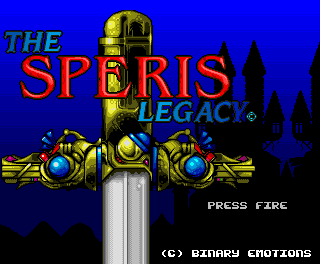
The Speris Legacy was released for the A1200 and CD32, but I found a pair of super r@re demo versions that were made for the A600! The ECS version has no flying sword, and the castle in the background is more bland.
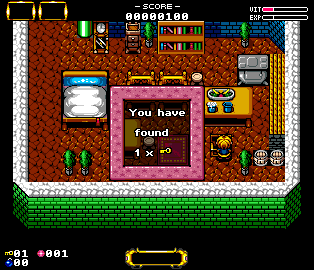
This demo only contains Sharma City as it appears in the final game, so it's a pretty lame demonstration of the Speris experience since it's about a minute long if you know where to get the key and where the sword is. By this point in development, Speris' slide to full Amiga-tude in the ingame interface was complete.
The ECS chipset has a coarser colour range and fewer simultaneous colours than AGA, so this is a very typical example of how a game's appearance would change from the first to the second generation of Amiga graphics. If I didn't know this was an AGA to ECS downgrade, I'd be surprised that the developers hadn't filled the black background on the AGA version with brightly coloured floating swords and things.
It's my suspicion that this is as far as the ECS version got before it was cancelled. They made the tiny prototype Gilliard Rhine for the A1200 first, then went mad and made it gigantic, and finally cowered in fear of their creation. It was too powerful for the A500 to contain. Maybe serendipity saved us all.
Anyway, that's all I've got. Hope you enjoyed it because it's time for everyone's favourite show, mecha-neko Moans About Speris.
CONCLUSION
The Speris Legacy is an innocent, very silly adventure, and a terrible game. It's a shambles, there's no doubt about it. It doesn't have a shoddy game engine, but the setting, the dialogue, as well as the action and everything that goes on within the game are all a big mess.
I apologise if at any point I made The Speris Legacy look like it was worth playing. I try my best to pick out the nice screenshots and make cool animations for your enjoyment, but in Speris' case the images give a very shallow impression of the game.
When you play Speris, you expect it to be a Zelda clone from the similarities in layout and controls. And, as a Zelda clone, it's abysmal. The game has a set of action-adventure gameplay mechanics, like weapons, combat and levelling-up, but Speris is mediocre in every aspect. Cho has hardly any moves, few weapons to choose between, and a bunch of boring, interchangeable enemies to fight. You'll have to fight through the tedious wants of everyone in a town as big as an entire game to get to the first real dungeon, and when you get there it lasts five minutes.
I'm glad that I played through the demos and read all the preview features I could find after writing the bulk of this post. They've shown me that I've made a crucial, basic error while playing The Speris Legacy based on its appearance:
The Speris Legacy was intended from the start to be an adventure game with a bit of action in it, mixing the custard of Monkey Island with the gravy of Dizzy. It's superficially a Zelda clone, but the game really wants to focus on the people Cho meets and the way he solves their problems. You could say it was the Disco Elysium of its day!
It just doesn't work, because it's really, really bad in every respect.
To me (and I'm hardly an adventure game fan or expert), a good adventure game has a strong sense of purpose throughout. Your characters begin with a goal they want to achieve, are given a goal by someone else, or are in a mysterious situation where the goal is to figure out what's going on. With a goal established, they then take rational steps to achieve it. They might get sidetracked performing another task in order to accomplish something necessary for their overall goal, or their objectives might change entirely if something causes them to re-evaluate the situation, but they're always trying to do something useful.
Cho's adventure has a goal, to pursue and apprehend Gallus, but the amount of relevant dialogue that either entertains the player with interesting story or directs the player with information on which they can act is miniscule. When he enters a town, Cho becomes a put-upon handyman, solving everyone's problems for no reason other than he's nice. All of the fetch quest chains in Gilliards Rhine and Cow Tree Village exist completely independently of the real goal you're trying to achieve. There's never any concession made in dialogue that justifies (however weakly) the link between the odd-jobs Cho has to do and the end result of the correct NPC materialising somewhere on the map who can open the one door that you actually want to open so you can move onto the next part of your pursuit. If somebody said 'Gallus was seen in the castle to the East, but the person who has that key is off travelling and they should be back tonight. Why don't you get me some bacon so I can cook you a meal and you can wait for them to arrive?', then you could have any number of Dizzy trades between you and the bacon and you'd still feel like you were making legitimate progress in your quest even though there's no real reason that eating bacon would cause somebody to return to town, and no reason why Cho would need a key when he owns a collection of mallets and a power drill.
For the most part, each town is self-contained, with no (obvious) reason to backtrack to other locations. This made me feel trapped - a prisoner rather than a visitor. Even though it would have stretched the weak adventuring gameplay out even further, it might have been better to have some of the stories take place across neighboring towns, so you get a change of scenery and music while travelling. That might have been what the various sections of Gilliards Rhine were supposed to feel like, but because the screen smoothly scrolls over the entire area with no barriers or transitions and no music changes, it feels never-ending. Because you don't feel like you're making any progress towards your overall goal of pursing and apprehending Gallus at any point, the objective at the forefront of your mind is always 'get out of the damn town', and the NPCs all feel like obstacles to the other, more fun parts of gameplay rather than being the main attraction as intended.
When Cho completes a task for an NPC, there's no reward for your effort. If you're hoping for the full character and motivations of the nefarious Gallus to be revealed over the course of the game, gradually uncovering his real nature as an anti-hero, you'll be disappointed. In Speris you'll spend upwards of thirty minutes delivering a knick-knack, and all you'll get in return is dialogue that, frankly, doesn't make a lot of sense. The reward in adventure games is in interesting or funny dialogue, or in entertaining animations. Speris doesn't bother with animations, so that just leaves the quality of the script. It's incredible that a lot of the dialogue was kept completely unchanged from the first demo to the final game. I can't believe that when they were going through the game redrawing the graphics and altering the interface, that the dialogue was the part they thought they'd nailed first time. It has the zany enthusiasm of something that was written quickly as a test, or something that you'd write as a 'first game' that you'd only show your friends.
The puzzles are abysmal, start to finish. Use a walkthrough liberally (external link) if you have the slightest confusion about your objectives. TECNO: The Base really kicked my butt, and each time I resorted to a walkthrough I felt that perhaps if I'd just been a little more observant or more of a lateral thinker I'd have solved the problem without any help. The Speris Legacy is deliberately super tricky and maddening. I mentioned in a comment on Ray's Noctropolis post that that game's adventuring was poor. Speris does a lot of the same things.
If you play Speris, accept that sometimes the solution to a puzzle will be to walk in and out of the same building a few times until an NPC is doing what you need them to do. Speris also loves mandatory hidden passages. I wish I'd made up that sequence about the hidden baby in the volcano, but it's all true.
There's a conversation system, like in a grown-up adventure game, but it will drive you berserk. Conversation topics disappear forever after you've used them, meaning that there's no way to get a reminder of your current remaining fetch quest objectives since all anyone will say to you is Good luck, Cho!
You find two different types of mallet in the game: a stone mallet and an ice mallet which never melts. The unmelting ice mallet has absolutely no ice-related powers - later in the game you have to pass through a scorching desert, but it has nothing to do with the ice mallet. The ice mallet is only used once, to smash an ordinary glass display case in someone's house after they've politely invited you inside. You have the stone mallet at that point, but it doesn't work. It sounds like that would've been a perfect time to use the drill, except the drill has no use whatsoever except to break through a single non-descript small grey rock at the entrance to a cave which Cho could have easily have climbed over. Never does attempting to use the wrong item to solve a puzzle ever give you an interesting response or a clue. It goes on in this vein.
The action part and the adventure part sometimes conflict in approach. For example, there's a Zelda-style keys counter in the bottom left, and it goes into the double digits, but I think there's only three keys in the entire game. You never kill a room of monsters in a dungeon to get a key and then choose which door to open. There's no dungeons! Each key is part of the plot, dedicated to a single door, as if they were key items. Later on, Cho starts getting a different set of keys that go in the OBJECT pocket, and never receives a standard key again.
The difficulty curve of the action part of Speris is backwards. It starts off difficult when Cho has a quarter-sized VIT bar, but it becomes nearly impossible to die part-way through Gilliards Rhine when you've got three times the health and you're familiar with every enemy type in the game. The only way to die in The Speris Legacy is to try to use a first-party Commodore CD32 pad, or to daydream hard enough you lose track of your health entirely. There's no low-health beeps in Speris, maybe because you're never in any actual danger. The most progress you can lose from dying is having to walk all the way from the upper-left of Gilliards Rhine to the lower-right again because you didn't know that touching the plant would instantly kill you.
And speaking of, that plant killed me because the controls in Speris are inconsistent. The Red CD32 button (✕ on a PS1 pad) is used for attacking with sword or bombs, talking to NPCs, raiding chests and inspecting signs and babies. The Blue button (◯ on a PS1 pad) is used for giving items to NPCs, using items in the world, picking up babies, and inspecting plants. The first time I found the baby in the hidden dungeon, I didn't know that Cho was supposed to pick him up and put him in his backpack along with his swords and bombs, because why would you? I thought I was supposed to bring the inventor from Gilliards Rhine into the dungeon with me somehow. I used the standard Talk button, got a description, and went on my way, only to have to fight my way back in there a second time after reading a walkthrough. Later, a similar scene plays out except Cho exclaims "Oh, I know someone who can help with this!" and after a fade to black, the necessary NPC is in the dungeon with him. It'll drive you mad.
So it's not a 'recommend' then, I'm afraid. You're better off playing... well, there's nothing really like Speris on any of the Amigas, and especially not the CD32. It wins by default by existing, which is cheating if you ask me.
In interviews (and confirmed by my sneaky examination of the hidden demo text), Binary Emotions said that the game was originally designed as a platform game, which would've made it almost identical to Arabian Nights.
I've played Arabian Nights to death. It's a very slick Amiga platform game with action-adventure-like goals revolving around item trading. Arabian Nights is slicker than Speris, has better music than Speris, has a cool main character, and, like Speris, promises to take you on a strange journey through different locations with outlandish characters to meet. Unfortunately, Arabian Nights is too damned hard, with annoying, near-unavoidable enemies and very few opportunities to recover health. Without infinite lives or passwords, Arabian Nights screeches to a halt and cancels the last three hours of progress, ruining the mood, and so is sentenced to a life at the very back of the games drawer where games whose first levels you can no longer stand rot for eternity, beside its brother Soccer Kid.
Arabian Nights and Soccer Kid might be respectable, but they're no good. The Speris Legacy is neither respectable nor good, but at least it isn't punishing.
The combat part of The Speris Legacy is the strongest part of it, possibly because the developers weren't very ambitious and so didn't spend any time messing it up after getting it working.
The scenery is nice and clear and easy to read. You can tell where Cho can and cannot go, even if you can't comprehend why certain barriers can only be defeated with certain items. Simply walking around is fun because the engine runs at a nice frame rate and you get to watch lampshade Cho swinging his little arms about.
When you hit enemies with the sword, they get knocked back and are unable to counterattack for a short time. Overwhelming enemies by trapping them against walls while you laugh is a satisfying skill you can quickly master. You can't block, but you can dodge, and there's invulnerability when you get hit. Because there's so few enemies in Speris, and unlike Dizzy there's no bloody holes in the ground filled with spikes to ruin everything, you can keep on trucking for as long as you feel you can stand it. I always felt like I could finished it if I only persevered a little longer. I think maybe the secret is that it doesn't give the player any reason to stop playing. That alone makes it so much more enjoyable to me than most other Amiga games.
What's truly terrifying about Gilliards Rhine is that after perhaps the second hour of wandering around listening to that music, you start to get into it. You begin to look forward to seeing the next strange character and finding out what they're all about.
I'm not a fan of over-complex games where you have to hold a lot in your head at once and the end result isn't realised for a long time. Speris' simple combat and occasional enemies to splat gave me something to do while I was scooting around the towns delivering things from place to place; there's multiple levels of mental
How does it compare to other games beyond the Amiga? Ray played Landstalker recently, so I gave it a go myself as well. The controls felt like I was craning my hand to reach inside a vending machine to steal stuff. Speris is more readily playable than one of the Mega Drive's premier action-adventure titles. How did that happen?
I'm starting to really come around to Speris the more I dwell on it. For all its stupidity, The Speris Legacy is full of charm. I suppose I just like anything that looks like a cartoon. It looks like it ought to be a good game. I'm becoming more frustrated that it isn't great than annoyed that it's bad. It just needed to be played through a few times by people other than the programmers. It would have to lose a bit of the wackiness (which would honestly be a shame) but with a more coherent story and interconnected hints, and with an improved version of the engine and mechanics, it could have been the start of a masterpiece.
I can only recommend The Speris Legacy to people who would like to play Zelda but lay awake at night wishing that it was an Amiga game. I don't mean 'a game on the Amiga', I mean 'an Amiga game'. If you're not prepared for what that entails, you're probably in for an unpleasant surprise.
Hi! Thanks for reading all those words that someone else wrote. I know mecha-neko appreciates it. In fact he'd appreciate it even more if you left him a comment about the game in the box.
(I'm sure he doesn't give a damn about whether you can guess the next game from the clue though.)



The 1995 demo title screen is lovely, in a PC Engine kind of way. Thumbs up for that, at least.
ReplyDeleteIt seems like they put the entrance to the shop on the north side of the building because they realised that leaving it on the south side would make it impossible to enter. Presumably it was easier to move the entrance than to rearrange the scenery so you could approach from the south. Or maybe everyone involved was insane. I don't know.
But wait, mecha-neko! As they say in the Indiana Jones films, "there is another". Dragonstone is an Amiga game that looks like a sword and sorcery version of Chaos Engine, but in fact plays like a Zelda clone. So your job is not yet done. Sorry.
The next game is Bill and Ted's Excellent Adventure, the point and click version that was on computers. Are we finally getting the long awaited -- by me and me only -- Keanu Reeves Week on Super Adventures?
Yes and yes.
DeleteWooo!
DeleteI mean, "excellent".
If you're partial to a bit of Keanu, one could say you were 'Keanu Reeves weak'!
DeleteI don't know whether to applaud you or hire an assassin.
Delete(rolls dice)
(applauds)
Please don't kill mecha-neko, I need him to write words.
DeleteAh it's okay, I rolled and got "applause".
DeleteI'm also saving up for a PS5 so I can't afford an assassin.
I love the implication that Kelvin rolled the dice and on seeing the result gave a slight nod and polite applause for their wise choice in choosing to dispatch me once and for all.
DeleteAs if I would be that cool and casual about the assassination of a popular computer game blogger!
DeleteAs much as I would normally prefer character portraits during dialog in games I guess it's a good thing that they removed them in this case. Aside from maybe the green haired lady in the bottom left, they all look... awfully inept, is probably the best way to put it. Cho's face in particular looks like it got beaten into shape with a spade!
ReplyDelete"One things for sure, once you`ve picked it up you`ll find it very hard to put it down again! Completion is possible due to high levels of playability in this game - I think some other companies ought to take a note of this point!"
This is hilarious considering you had to abandon the game due to a game-breaking bug! 😂 Also, 'completion is possible due to high playability'? What is that even supposed to mean? I mean yeah, good 'playability' is certainly better than a bad one, but did they really think it was a special feature (and not taken for granted) that their action RPG was actually - you know - possible to finish?
That was an awesome article(s)! Thanks for pointing out that it’s awful. Time won’t be wasted on it. My brain tried to use the Zeldaesque screenshots to convince me that it looked interesting.
ReplyDeleteHaha, you're welcome. Though, like the Matrix, nobody can truly be 'told' what Speris is like. You have to play it for yourself.
DeleteAmazing! This is the game I read about in magazines when I was a kid, but never found as an adult. I forgot the name, but I remember it vividly because it looked so much like Link to the Past. I thought it was cancelled since I never found anything that looked like it. And no wonder I never found it: They changed the game's visuals so much!
ReplyDelete:D Glad to have brought back some memories. If you decide to give Speris a try, let us know what you think of the game.
DeleteThe mounting frustration I felt through your writing made me think the end of part 3 would be a screenshot of your amiga after you'd thrown it out the window - and part 4 would be an amiga repair article.
ReplyDeleteSperis Legacy isn't that bad... kind of... well, perhaps wrap your Amiga in something soft before you start playing.
ReplyDeleteNote: Super Adventures does not endorse or recommend wrapping your game machines in insulation before playing.
DeleteCritcisms noted ;)
ReplyDelete